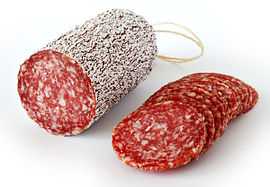Bologna sausage
Bologna sausage, sometimes phonetically spelled as baloney (/bəˈloʊni/),[1] boloney or polony, is a sausage derived from the Italian mortadella, a similar looking finely ground pork sausage containing cubes of lard, originally from the Italian city of Bologna, IPA: [boˈloɲɲa]). U.S. Government regulations require American bologna to be finely ground [2] and without visible pieces of lard. Bologna can alternatively be made out of chicken, turkey, beef, pork, venison or soy protein. Unlike the mortadella Bologna, bologna sausage is not an Italian product and there are several differences among process and ingredients. Typical seasoning for bologna includes black pepper, nutmeg, allspice, celery seed, coriander, and like mortadella, myrtle berries give it its distinctive flavor.[3]
Polony is the name for a large sausage created from a mixture of beef and pork that is popular in South Africa and was very popular in Britain during the 17th and 18th centuries. Polony is now eaten less often. Polony can be stored for long periods, sometimes many weeks. Polony is highly seasoned before being hot smoked. It is then cooked in boiling water when required.
German bologna
Sometimes referred to as garlic bologna, this sausage differs from traditional bologna due to various seasonings, most typically garlic being added to the recipe. Although referred to as German Bologna elsewhere, it is usually called Fleischwurst in Germany and Extrawurst in Austria. Other varieties, such as the French variation are sometimes called "Saucisse de Lyon" which the Swiss call Lyoner or Lyonerwurst ("Lyon sausage") and usually do not contain a noticeable amount of garlic, while Fleischwurst is often flavored with garlic, these varieties are generally an off white color, as they do not contain nitrates (which give cooked pork its pink color).
In Germany, "regular" bologna is referred to as Mortadella, and is mostly identical and made out of the same meats as its American counterpart, although it often contains pistachios. The original, larger and less finely ground Mortadella is called italienische Mortadella.
Kosher or halal bologna
Kosher or halal bologna is typically made with only beef, but sometimes made from turkey, chicken or lamb.
Lebanon bologna
Lebanon bologna is a Pennsylvania Dutch prepared meat. While nominally bologna, it is a dried, smoked sausage similar to salami.
Ring bologna
.jpg)
Ring bologna is much smaller in diameter than standard bologna. It is a good size for slicing and putting on crackers as a snack or hors d'oeuvre (as opposed to the "sandwich-sized" slices of typical bologna). It is generally sold as an entire link rather than pre-sliced. The link is arranged as a semicircle or "ring" when prepared for sale (hence the name).[4] Pickled bologna is usually made from ring bologna soaked in vinegar and typical pickling spices.[5] It is usually served in chunks as a cold snack.
Lauantaimakkara
Lauantaimakkara is a Finnish type of bologna derived from the early Lyon sausage, the "Lyoner".
Rag bologna
Rag bologna is a long stick, or "chub" of high fat bologna traditionally sold wrapped in a cloth rag. The recipe has a higher content of filler than that of regular bologna. Milk solids, flour, cereal and spices are added during processing, and the roll of bologna is bathed in lactic acid before being coated in paraffin wax. This type of bologna is native to West Tennessee[6] and the surrounding regions and is not commonly available outside this area. It is generally eaten on white bread with mustard and pickles, but is also a staple of family gatherings where thick slices are smoked and barbecued along with other meats. In Newfoundland, a type of rag bologna referred to as "wax" bologna is sliced thickly and fried, which is referred to as "Newfie steak".
South African polony
South Africans refer to bologna exclusively as 'polony', although South African polony is typically made using highly processed meat with a high pink slime concentration. These processed meat products are typically an artificially bright pink color, and are a low-income food due to their low cost. Large pink, bland polonies are called French Polony , with thinner rolls referred to simply as polony. Garlic Polony is also widely available.
See also
- Bologna sandwich
- Giò lụa - a Vietnamese sausage, similar to bologna
- Falukorv
- Leberkäse
- Lebanon bologna
- List of smoked foods
References
- ↑ "baloney." Dictionary.com Unabridged. Random House, Inc. 14 Oct. 2011. <Dictionary.com http://dictionary.reference.com/browse/baloney>.
- ↑ Hot Dogs and Food Safety
- ↑ http://www.huffingtonpost.com/2013/10/24/national-bologna-day-what-is-in_n_4151151.html
- ↑ "What is Ring Bologna". wiseGeek. Retrieved 27 August 2014.
- ↑ In the Midwest, Great Bologna Is a Way of Life, Sara Bir, November 3, 2014
- ↑ "Fineberg Packing Co., Inc.". Fineberg Packing Co., Inc. Retrieved 17 December 2014.
| ||||||||||||||||||||||||||||||||||
